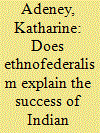|
|
|
Sort Order |
|
|
|
Items / Page
|
|
|
|
|
|
|
| Srl | Item |
| 1 |
ID:
152461


|
|
|
|
|
| Summary/Abstract |
Ethnofederalism has been contested as a solution for diverse societies as seen recently in Nepal (where federalism has been accepted, but the design and number of units remains heavily contested) and Myanmar (where ethnic minority demands for increasing federalization have had to take a back seat to the demands for increasing democracy). It remains a heavily contested subject in Sri Lanka. Concerns are expressed that ethnofederalism will increase pressures for secession and/or lead to increased violence through increasing a sense of separateness of the people living within that territory, providing resources for political entrepreneurs to mobilize groups against the center and will lead to the persecution of minorities within the ethnofederal units. India is an example of a federation that appears to demonstrate that ethnofederalism decreases rather than increases conflict through its successful reorganization of states along linguistic lines. However, a group-level analysis reveals a more diverse picture. India has simultaneously been both a success and a failure at conflict management.
|
|
|
|
|
|
|
|
|
|
|
|
|
|
|
|
| 2 |
ID:
143939


|
|
|
|
|
| Summary/Abstract |
This article analyzes the continuing interethnic and anti-state violence in Assam, India after the creation of the semi-autonomous Bodoland Territorial Area District (BTAD) in 2003. We argue that this institutional arrangement, as an “innovative” model of ethnofederalism and political autonomy, has been unsuccessful in effectively preventing continued violence. We identify several dynamics resulting from the creation of the BTAD that contribute to its ineffectiveness, including the emergence of parochial and militarized Bodo ruling cliques, competitive radicalization between Bodo political elites competing in insular electoral constituencies, the inability to co-opt and integrate factionalized Bodo militants, reinvigorated non-Bodo activism and communalism, and the increased politicization of land. The extreme and multi-faceted “ethnic” diversity found in India’s Northeast, and its aggressive political expression at the local level, differentiates this region from other parts of India where ethnofederalism has been comparatively more successful for conflict mitigation. Thus, the prospects for successful ethnofederalism are area-specific.
|
|
|
|
|
|
|
|
|
|
|
|
|
|
|
|
| 3 |
ID:
090417


|
|
|
|
|
| Publication |
2009.
|
| Summary/Abstract |
This article attempts to explain how the Georgian state sought to manage ethnic diversity at the same time as (re-)building state institutions within a (nominally) democratic framework, from the collapse of Soviet power to the present day. It is suggested that the explanation for the slow and uneven progress in accommodating national minorities within the Georgian state derives from four principal factors: first, the collapse of the Soviet state and the consequent inability of the newly independent state to provide basic public goods; second, the lack of a 'civic' model for the accommodation of minorities; third, the continuation of the Soviet norm of arbitrary exercise of power by leaders, which is ill-suited to accommodating diversity and resolving conflict; and, finally, the Soviet legacy of ethnofederalism, which carved out three autonomous territories - Abkhazia, Achara and South Ossetia - from within Georgia that would (violently, in the case of Abkhazia and South Ossetia) resist the encroachments of the new Georgian state, and would later (in the case of South Ossetia) provide a pretext for military conflict between Russia and Georgia.
|
|
|
|
|
|
|
|
|
|
|
|
|
|
|
|
| 4 |
ID:
190880


|
|
|
|
|
| Summary/Abstract |
Extant research highlights low or unequal access of ethnic groups to socio-economic resources as a driver of communal violence. However, less is known about how institutional factors, such as control over ethnofederal units, influence the distribution of these resources in the first place. Conversely, the literature on ethnofederalism has focused on conflicts that involve the central government, while neglecting its unintended consequences at the subnational level. Building on both literatures, we argue that ethnofederalism increases the risk of communal violence between locally dominant and non-dominant groups through two mechanisms. First, it increases grievances among locally non-dominant groups. Second, it increases the utility of coercive strategies for locally dominant groups. Through both processes, ethnofederalism creates incentives for group elites to use communal violence in order to attain or maintain control over local government office. We test our argument in a subnational analysis of Ethiopia’s ethnofederal system, combining new spatial data on local demographics, government control, and horizontal inequalities. We further substantiate our analysis with quantitative tests of the mechanisms’ intermediate implications and with original interview data gathered during fieldwork. Our results highlight the importance of accounting for institutional factors in the comparative study of communal violence.
|
|
|
|
|
|
|
|
|
|
|
|
|
|
|
|
|
|
|
|
|